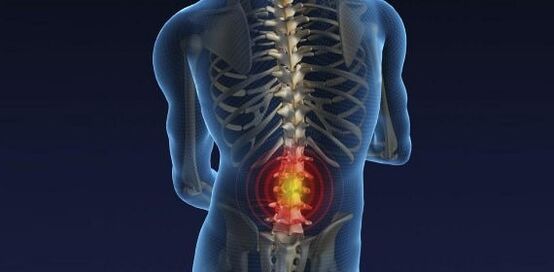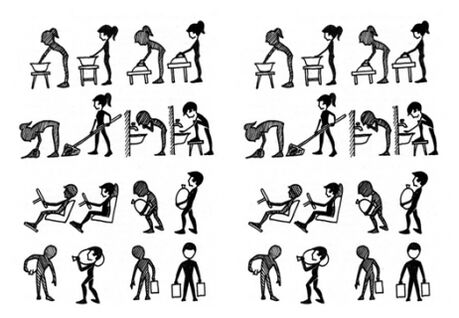
Pain in the back and limbs is one of the most common disorders.It is the second most common cause of medical care after respiratory illness.About half of people of work age during their lives endure episodes of back pain and prolonged disability.
What is osteochondrosis
Osteochondrosis is a disease in which the degeneration of the intervertebral disc occurs.
The intervertebral disc consists of a fibrous ring (concentric layers of strong connective tissue fibers) and a jacket core in the center.The disks part makes up about a quarter of the spine length, they play the role of shock absorbers - with a vertical position, curves, tendencies and spine extension, core and fibrous river of the disc, it receives axle loads, it occupies that starting position.A significant load falls on the discs of the lumbar and cervical spine, as these departments have the highest mobility.This explains the fact of the greater severity of degenerative changes in the cervical spine and lumbar.
One of the causes of disk degeneration is their insufficient nutrition, which, in turn, is a consequence of a person's poor physical activity.
Water content and elastic disk properties are also significantly reduced with age.The fibrous ring of the disk loses its elasticity, the cracks appear in it, in which, in each new load, the jacket nucleus begins to present more and more, moving to the edge of the disk, with the full rupture of the fiber ring, the content of the nucleus goes beyond its borders - there is a hernia of the jacket.Most often, an lateral displacement of the disk occurs in the direction of the intervertebral hole through which the spine passes.In this regard, the most common manifestation of a hernia is to squeeze the corresponding root and the development of a characteristic pain syndrome.Under the influence of pulses by the affected segment receptors, the spinal muscles reflectively, their asymmetrical stress causes the spinal scrap side bending
Risk factors for osteochondrosis
Currently, risk factors for the emergence of manifestations of osteochondrosis pain include:
- hereditary weaknesses or congenital defects of the spine;
- spinal damage leading to structural changes;
- severe and unbalanced physical activity;
- long stay in a forced position with distortion and twist;
- Hypodynamia, inactivity, monotonous work.
Contributing factors to the emergence of osteochondrosis and its irritations can be various infectious diseases, colds, excessive work, energy disorders, including vitamin deficiency, overweight, environmental factors and habits, endocrine disorders, etc.
What to do if the back is sick
Pain is a warning signal and protects against impairment of effects within the body.First, the pain occurs when it moves, changing behavior and passes to rest, while the disease progresses, occurs in the morning rigidity, which can last 30-60 minutes.The duration of the disease can be several weeks or months.
What should you do if your back hurts?Be sure to consult a doctor during the first 3-5 days (to avoid chronicing the disease).Use simple tips, in addition to the doctor's recommendation:
- Overload should be avoided.To avoid problems, try to constantly monitor the right body position.Excess weight increases the load on the back.Not all sports are the same useful.It is better to avoid game sports and jump and choose walks, ski and swimming - they will only benefit from the backbone.

- Organize sleep, nutrition and rest correctly.For the maximum effect, choose a fairly tough mattress and an orthopedic pillow will be the best choice.
- Organize your workplace correctly.Chairs with a low place, prone to the back, which should be convex in the place of the lumbar back (or recommended to put a roller), will be ideal.
- Handling position.With a fairly high roll installed under the lower lord of the lumbar, the "tense" muscles rest, the pressure on the back of the damaged spine discs of the lumbar decreases, the pain decreases.After a working day, it is advisable to spend 30-60 minutes in this home position before bedtime.
- Therapeutic gymnastics (exercise therapy).Gymnastics forms a strong muscle corset around the spine, cost 15-25 minutes daily (you can for 2-3 approaches).The group of exercises should be prescribed by the treating physician depending on the intensity of the pain, at the end of the article we will give the most common complexes of therapeutic exercises depending on the period of illness (acute phase, forgiveness, etc.)
Recommendations of motor mode in acute period
In the acute periodIn the presence of acute pain, the strict part of the bed should be observed.LFK is mainly used for hygiene and is of general strength in nature.Pain -causing exercises should be limited to amplitude, muscle tension rate or excluded at all.Not very important not to get involved in pain and do everything too slowly, repeating every exercise 8-10 times.
When moving the lower extremities, prevent an increase in lumbar lordosis (bending the spinal column forward), which can improve pain syndrome.In the second phase of the acute period, with a decrease in pain intensity, you should carefully include isometric exercises for training the abdominal muscles and large gluteal muscles.
With a decrease in pain syndromeOpportunities to use special and developmental exercises increase.In this period, in addition to exercises that increase the strength of the abdominal muscles and hip muscles, the exercises are important, with the bending of the lumbar back.
When choosing special and developing exercises, it is important to ensure that they do not increase the lord lordosis.Pain is a signal for a change in the exercise structure (toward relief) or to exclude it.At the end of the second period, you should gradually include exercises that increase the strength of the back muscles, they can be performed in a circular system 2-3 times.They are the most important.Get the number of repeat of special exercises in 15-50 times.The pace of exercise can gradually increase.
In the period of forgivenessAdded exercises to increase spinal column mobility.However, exercises aimed at solving this problem should be carried out carefully and in light initial positions.Automation should be achieved by maintaining a specific stand in the standing position and while walking, when the lumbar spine is bent.Reduce repetitions of special exercises of the second period increases to 50-100 times (may break during the day).The use of swimming pool therapy is recommended for the period, but gymnastics in the pool does not replace, but meets the main "dry" classes.
From other tools of exercise therapy, it is recommended to use those that will not affect the negative ways in damaged discs: swimming, terrain, skiing, runway, bicycle ergometer, exercises with a rubber band.Apply tools such as volleyball, tennis (large and small), road bicycles, cross jogging, fast dancing, rhythmic gymnastics should be extremely careful, as sudden movements and curves can provoke an exacerbation of osteochondrosis.Dumbbell exercises are probably performed in the lie (on the back, abdomen) to exclude vertical loads on the back.
Exercises that use pure hanging due to the strong tension of the stretched muscles of the body, jumping into deep height, exercises in the cannon machine and casting are undesirable.In any case, during exercise therapy, it should be remembered that the constant damage and congestion of the spine, shocks along the spine shaft prepare the right background for damaging the damaged disk and irritating the pain syndrome.























